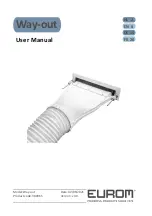
7
CHARACTERISTICS OF THE HEATING
OPERATION (HEATING OPERATION AND
AUTOMATIC HEATING OPERATION)
START OF OPERATION
•
It generally takes a longer time for indoor
temperature of the HEATING OPERATION to
reach the set temperature compared to the
COOLING OPERATION. It is advisable to start
capacity decrease and discharge of cool air.
AT THE START OF OPERATION AND AFTER
THE DEFROST OPERATION
•
A warm air circulating system is employed, and
therefore it takes some time until the entire room
is warmed up after the start of operation.
•
The indoor fan runs to discharge a gentle wind
automatically until the temperature inside the air
conditioner reaches a certain level. At this time,
the remote controller displays “
”. Leave it as
it stands and wait for a while.
(The remote controller displays the fan speed that
is set.)
•
The airflow direction becomes horizontal to
prevent a draft of cool air to the inhabitants.
(The remote controller displays the airflow
direction that is set.)
DEFROST OPERATION
(Frost removal operation for the outdoor
unit)
•
As the frost on the coil of an outdoor unit increase,
heating effect decreases and the air conditioner
goes into the DEFROST OPERATION.
•
The indoor unit fan stops and the remote
controller display shows “ ”.
With the wireless remote controller, the warm air
stops, and the DEFROST OPERATION lamp on
the light receiving unit turn on. (The remote
controller displays the fan speed that is set.)
•
After maximum 10 minutes of the DEFROST
OPERATION, the air conditioner returns to the
HEATING OPERATION.
•
The airflow direction becomes horizontal. (The
remote controller displays the airflow direction
that is set.)
•
During or after the DEFROST OPERATION, white
mist comes out from the air inlet or outlet of the air
conditioner.
(Refer to “
4.
” on page 14.)
•
A hissing and “Shuh” sound may be heard during
this particular operation.
Regarding outside air temperature and
heating capacity
•
The heating capacity of the air conditioner
declines as the outside air temperature falls.
In such a case, use the air conditioner in
combination with other heating systems.
(When a combustion appliance is used, ventilate
the room regularly.)
Do not use the combustion appliance where the air
from the air conditioner is blown directly toward it.
•
When the warm air stays under the ceiling and
your feet are cold, we recommend that you use a
circulator (a fan to circulate the air inside the
room). For details, consult your local dealer.
•
When the indoor temperature exceeds the set
temperature, the indoor unit discharges a gentle
breeze (switches to gentle wind). The airflow
direction becomes horizontal. (The remote
controller displays the fan speed and airflow
direction that are set.)
CHARACTERISTICS OF THE PROGRAM
DRY OPERATION
•
This operation lowers the humidity without
lowering the indoor temperature. The indoor
temperature when the operation button is pressed
will be the set temperature. At this time, the fan
speed and temperature are set automatically, so
the remote controller does not display the fan
speed and set temperature.
To efficiently lower the indoor temperature and
humidity, first use the COOLING OPERATION to
lower the indoor temperature, and then use the
PROGRAM DRY OPERATION. When the indoor
temperature is lowered, airflow from the air
conditioner may stop.
•
When operating continuously at downward airflow
direction, air blows in the automatically set
direction for a period of time to prevent condensation
on the horizontal blade. (The remote controller
displays the airflow direction that is set.)
•
If the PROGRAM DRY OPERATION is used when
the indoor temperature is low, frost forms the heat
exchanger of the indoor unit. In this case, the air
conditioner automatically switches to the
DEFROST OPERATION for a while.
The low fan speed or a gentle wind is used to
prevent the discharge of melt water.
operation in advance using the TIMER OPERATION.
Perform the following operation to prevent heating






































